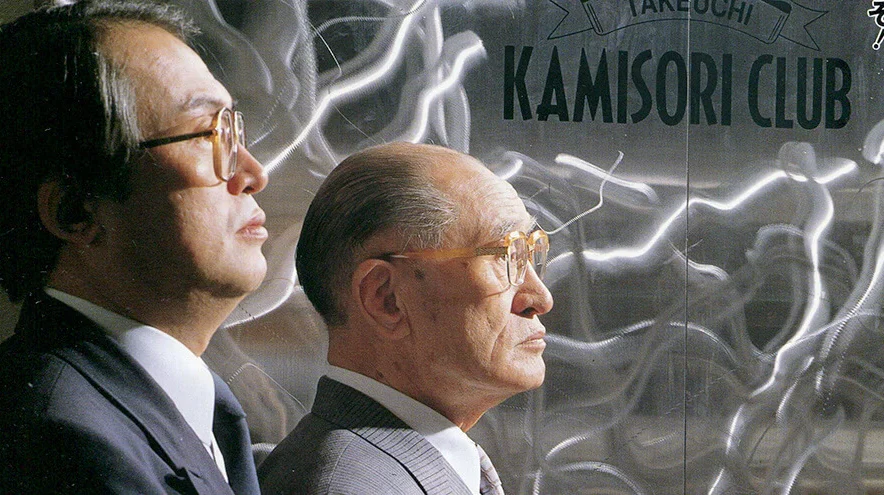Contributed by Yasuoki Takeuchi, President, Razor Club
The beginning of the 21st century brought with it a major and unexpected event: the acquisition of Warner-Lambert and Gillette, the parent companies of Schick. The parent companies of Schick, Warner-Lambert of the U.S. and Gillette of the U.S., were acquired through mergers and acquisitions in rapid succession. Both of these companies have sales of 5-6 trillion yen.
This was a global strategy in the American style, and a typical example of such a strategy. In fact, Gillette, Schick, and Wilkinson are global brands that focus on blade replacements, and no other razor manufacturer can match them in terms of production scale and technology.

July 5, 1983 at a hotel in Tokyo
Late father, Kinzo Takeuchi, 69, meets with Mr. J. Williams, Chairman of Warner-Lambert Company, U.S.A.
(WL), the parent company of Sick Razor, was acquired by Pfizer Inc. of the U.S., the world’s largest pharmaceutical company in the same business, and the company was renamed Pfizer Consumer Inc. in April 2002. The company changed its name to Pfizer Consumer Inc. in April 2002. The following year, in January 2003, Pfizer Inc. agreed to divest its shaving business divisions, including Schick & Wilkinson, and sell them to Energizer Inc. of the United States, which focuses on batteries. In the Japanese market, the related business units were spun off to form Schick Japan K.K., and Shinichi Goto was appointed as the Japanese president in 2009.

At Sanpo Shoji’s head office showroom
July 28, 1986 Author: Yasuki Takeuchi, age 43
Request from D. Wilder, Lieutenant Governor of Virginia, U.S.A. (later to become the first black governor), to promote the importation of razors
In 2006, Gillette was acquired by Procter & Gamble (P&G), the world’s largest manufacturer of household detergents and other toiletries. (P&G), the world’s largest manufacturer of household detergents and other toiletries. Gillette, headquartered in Boston, is a prestigious company with a long history dating back to 1904, and boasts the largest market share of any razor manufacturer in the world. Gillette also owned Braun electric razors and Oral-B toothbrushes. In terms of products, in 2004, Gillette launched the electric male system 3-blade Mach M3 Power, and Sick also launched the 4-blade Quattro 4. In 2004, Gillette launched the 3-blade Mach M3 Power electric male system, followed by the 4-blade Quattro 4 from Schick. Following this, in 2005, Feather, a domestic company, launched the 3-blade F-System MR3 Chrome Holder. In the latter half of 2006, P&G introduced the Gillette Fusion 5+1, a 5-blade system for men. 5+1″ was launched and attracted worldwide attention. Meanwhile, Kaijirushi, which focuses on disposable products, launched a new 5-blade high-end disposable razor, “Premium Disposable 5,” in 2008.

at Sankei Kaikan, Otemachi, Tokyo
November 27, 1989
Shaving Culture Museum and Razor Club Establishment Announcement
The author, Yasuoki Takeuchi, 46 (left)
The late father, Kinzo, 75 (right)
On the other hand, innovation also occurred in the women’s market, with the development of a succession of three-blade and electric razors based on design preferences, such as Gillette Venus and Chic Intuition, as well as products with special processing, all of which are the same type of body razors used in the US and European markets. The L-shaped face-shaving razors used mainly by Japanese women are almost exclusively the products of domestic manufacturers. The “Thick Revolution,” a holder with an attachment that enables beard grooming, was also a hot topic. In the field of shaving-related products, Chic launched a new gel-type pre-shaving product containing aloe extract and charcoal (a cleaning agent) in 2009, competing with shaving foam and other general men’s cosmetics manufacturers. In 2009, a new gel-type pre-shaving product containing aloe extract, charcoal (a cleaning agent), and other ingredients was launched.
Looking back, the past decade since the beginning of the 21st century has not been a long period, but it has been a whirlwind of upheaval and change. The dynamic merger of two manufacturers through M&A and the introduction of groundbreaking new products such as 4-blade and 5-blade razors were at the forefront of the current trends. The introduction of groundbreaking new products, such as four-blade and five-blade razors, was also a major step forward in the industry’s evolution. In the past, only the blade itself was processed in the era of double-edged blades, but today’s razors use plastic and special chemical agents and are now cartridge-type. Although the cost of replacement blades has increased, consumers like the new razors because they are safer. The improved sharpness is also the result of high-quality razor materials (steel strip), and naturally, the number of uses per blade has increased. In an interview with Mr. Honda, Chairman of Hitachi Metals, the world’s largest razor material supplier, in July 2009, he spoke enthusiastically about various aspects of recent blade replacements. The deflationary trend and the strong yen that followed the collapse of Lehman Brothers in the U.S. in 2008 have depressed overall sales of razors, but the Razor Club’s online sales of high-end razors as gifts has created a new market and is attracting interest.

